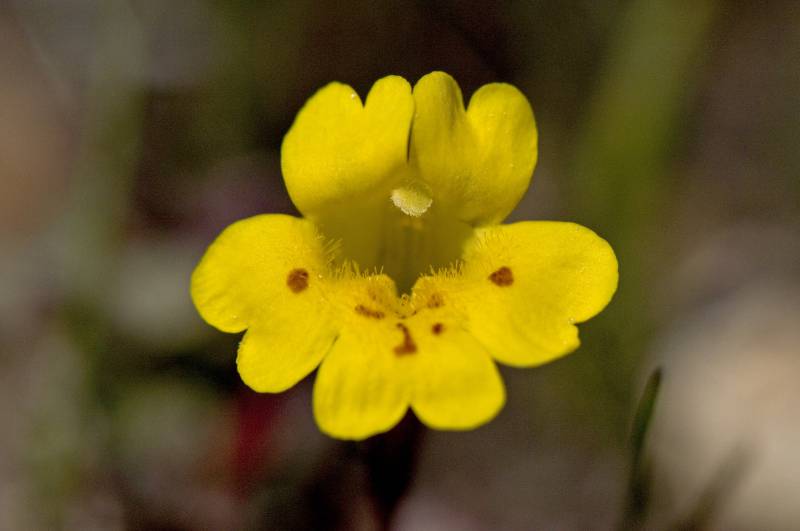Erythranthe primuloides
Erythranthe grandis
primrose monkey-flower
large monkey-flower
Leaves opposite, crowded near the ground, short-hairy abaxially (underside), viscid to glabrous adaxially (upperside);
leaves oblanceolate, sessile, nearly entire, 3-nerved from the base, 7-25 mm. long and 3-11 mm. wide.
Leaves basal and cauline, basal leaves generally not persistent;
petioles 10-80 mm, becoming reduced distally;
blade ovate to broadly elliptic, 25-60 mm long and 20-40 cm broad, palmate or nearly pinnate venation with 5-7 veins, base truncate to nearly cruneate to nearly cordate, margins crenulate to toothed, occasionally sublyrate near base, apex rounded to obtuse, surfaces of distalmost leaves hairy as stems.
Flowers solitary on slender pedicels up to 10 cm. long arising from the leaf clusters;
calyx narrow, 4-8 mm. long, mostly glabrous, the 5 teeth short, equal;
corolla yellow, often dotted with maroon, 1-2 cm. long, scarcely bilabiate, the 5 lobes spreading, shallowly notched, the throat somewhat flaring;
stamens 4.
Inflorescence racemose, bracteate, flowers 8-26; fruiting pedicels 10-35 mm, hairy as stems;
calyx straight-erect or nodding at 45-100 degrees, ovate to bell-shaped, inflated, compressed along sagittal plane, 15-22 mm, hairy as stems, throat closing;
corollas yellow with red spots inside, symmetric bilaterally, bilabiate;
tube-throat widely funnel-shaped, 16-24 mm, protruding 10-15 mm beyond calyx margin, limb widely expanded;
styles hirtellous;
anthers not protruding, glabrous.
Capsule.
Capsules 8-12 mm, included.
Erythranthe primuloides
Erythranthe grandis
- Local floras:
CA,
OR,
WA
- Local Web sites:
CalFlora,
CalPhotos,
Flora NW,
PNW Herbaria
WildflowerSearch
iNaturalist (observations)
- LBJ Wildflower Center
- SEINet
- Plants of the World Online
- Encyclopedia of Life
- Wikipedia
- Google Image Search
- Local floras:
CA,
OR,
WA
- Local Web sites:
CalFlora,
CalPhotos,
Flora NW,
PNW Herbaria
WildflowerSearch
iNaturalist (observations)
- LBJ Wildflower Center
- SEINet
- Plants of the World Online
- Encyclopedia of Life
- Wikipedia
- Google Image Search



